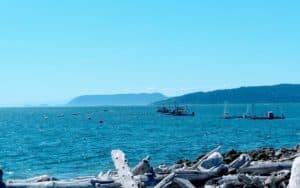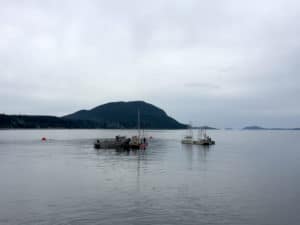Getting Ready For Fishing Season
By Riley Starks, Marketing Manager, Lummi Island Wild
All of the 9 reefnet gears in Legoe Bay are finally ready to fish. We used our tender, the Galactic Ice, to set two 3000 lb concrete anchors to replace some that had become useless due to corrosion and other factors. As you can see from the photo, the gears are lined up in two rows, called row one and row two.

Reefnet gears out in Legoe Bay
There was a time when there were nine rows; my first gear was in row three, which no one uses any more. The attrition was due to a renegotiation of the Canada-US treaty that governs sharing the salmon runs going to the Fraser River. Our share of the fish got traded away, and as compensation there was a buy-back program instituted in 2002. Reefnets went from 52 permits to 11, drawn by lottery.
From shore, the very first gear you can see is the new one owned by Larry Kinley, a Lummi tribal elder. Lummi Island Wild set the anchors and helped design this gear.

Setting up Larry Kinney’s gear
It is the first tribally owned reefnet since the summer of 1897, when the state legislature banned all reefnets within 2400 feet of any salmon trap. Salmon traps, owned by corporations which also built canneries, filled Legoe Bay and displaced the traditional tribal reefnets that had been set up each summer for a thousand years. The loss of these fishing grounds was devastating to the tribal families, and gradually all profitable family sites from the Fraser River to the San Juan islands were displaced by non-indian fish traps. When fish traps were outlawed in 1935, after decades of wasteful practices and wanton disregard for the resource, the population on Lummi Island was more than 7,000. Fish trap workers and others scrambled to build new reefnets, and tribal members never got the chance to reclaim their sites. Through the efforts of many, that is changing and tribal fisheries are growing again!


